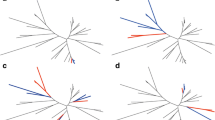Abstract.
If lateral gene transfer (LGT) has affected all genes over the course of prokaryotic evolution, reconstruction of organismal phylogeny is compromised. However, if a core of genes is immune to transfer, then the evolutionary history of that core might be our most reliable guide to the evolution of organisms. Such a core should be preferentially included in the subset of genes shared by all organisms, but where universally conserved genes have been analyzed, there is too little phylogenetic signal to allow determination of whether or not they indeed have the same history (Hansmann and Martin 2000; Teichmann and Mitchison 1999). Here we look at a more restricted set, 521 homologous genes (COGs) simultaneously present in four sequenced euryarchaeal genomes. Although there is overall little robust phylogenetic signal in this data set, there is, among well-supported trees, strong representation of all three possible four-taxon topologies. ``Informational'' genes seem no less subject to LGT than are ``operational genes,'' within the euryarchaeotes. We conclude that (i) even in this collection of conserved genes there has been extensive LGT (orthologous gene replacement) and (ii) the notion that there is a core of nontransferable genes (the ``core hypothesis'') has not been proven and may be unprovable.
Similar content being viewed by others
Author information
Authors and Affiliations
Additional information
Received: 7 November 2000 / Accepted: 20 February 2001
Rights and permissions
About this article
Cite this article
Nesbø, C., Boucher, Y. & Doolittle, W. Defining the Core of Nontransferable Prokaryotic Genes: The Euryarchaeal Core. J Mol Evol 53, 340–350 (2001). https://doi.org/10.1007/s002390010224
Issue Date:
DOI: https://doi.org/10.1007/s002390010224




